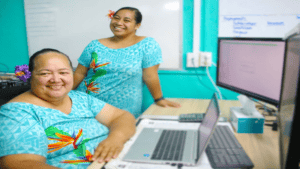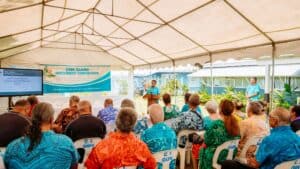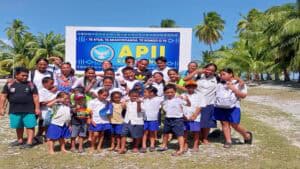The Cook Islands recently hosted the prestigious Underwater Minerals Conference (UMC), an event that underscored our nation’s growing influence in the global seabed minerals industry. This marked only the second time in UMC’s 52- year history that a South Pacific country has taken the spotlight, and it’s clear why the Cook Islands was chosen.
With decades of scientific exploration, innovative policy, and a strong commitment to protecting our ocean resources, the Cook Islands is leading the way in sustainable seabed minerals exploration—laying the groundwork for opportunities that could benefit generations to come.
What Lies Beneath: Polymetallic Nodules:
Far beneath the waves, over 4,000 meters down in the dark Abyssal Zone, lie potato-sized polymetallic nodules. These nodules contain valuable metals such as manganese, nickel, copper, and cobalt—resources critical to the growing demand for renewable energy technologies like electric vehicles and solar panels.
Within our vast Exclusive Economic Zone (EEZ), which covers nearly 2 million square kilometers, these nodules hold immense potential. In fact, Cook Islands nodules are particularly rich in cobalt, making them a unique asset for addressing the global transition to cleaner energy.
The discovery of these nodules over 50 years ago set the wheels in motion for an extraordinary journey of exploration. It began with Sir Albert Henry, our first Prime Minister, who in 1974 addressed the United Nations,
sharing his vision of how these seabed resources could secure the future of the Cook Islands. His words laid the
foundation for decades of scientific and policy advancements, all aimed at ensuring that the development of these resources benefits the people of our islands.
Decades of Research and Progress:
Since 1974, the Cook Islands has conducted more than 20 research expeditions to explore the potential of our seabed. In 2009, we became the first country in the world to establish a dedicated Seabed Minerals Authority,
providing a robust legal framework for managing these resources. This was strengthened in 2017 with the Marae Moana Act, which introduced protections across our entire EEZ.
After a decade-long pause in exploration, activity resumed in 2019 when Cobalt Seabed Resources Limited (CSR) conducted a major research campaign, collecting over 120 samples from depths of 5,000 meters. This was followed by the issuance of exploration licenses in 2022, allowing three companies to begin scientific work to better understand the potential of these nodules.
Exploration, however, is just the beginning. As Seabed Minerals Authority Commissioner Alex Herman explains:
“Establishing this framework for minerals harvesting is a separate process from deciding whether such activities will occur. The Cook Islands Government requires additional scientific data to ensure any decision on seabed mineral extraction is science-based. Until then, only exploration activities can proceed.”
A Local Highlight: UMC 2023 in Rarotonga:
The recent UMC, themed “Going Deep: Getting the Science Right for Informed Decisions,” brought global experts to our shores and, for the first time, opened its doors to local residents for free. Many Cook Islanders attended the sessions, gaining firsthand insights into the science and opportunities of seabed minerals.
Prime Minister Mark Brown, speaking at the conference, highlighted the importance of involving Cook Islanders in these discussions: “This is about our future. We must ensure any development of our resources is done responsibly and benefits all Cook Islanders.”
What It Means for Cook Islanders:
The potential benefits of seabed minerals exploration are significant. If managed responsibly, the revenue generated could support vital initiatives like healthcare, education, and infrastructure—especially for our Pa Enua communities. But the Cook Islands is taking a measured approach, ensuring environmental and cultural values are prioritized alongside economic opportunities.
The conference also showcased how Cook Islanders are directly contributing to this industry. General Manager of CSR, Eusenio Fatialofa, a proud Cook Islander, led knowledge-sharing sessions at the event. His experience and leadership demonstrate the opportunities for our people to take part in this emerging field, both locally and internationally.
A Vision for the Future
Prime Minister Brown closed the conference with a clear message: the Cook Islands has a chance to lead the world in sustainable seabed mineral exploration. But it will do so carefully, with science, community, and future generations at the heart of every decision.
“If managed properly, seabed minerals could significantly contribute to our country’s social, environmental, and economic wellbeing.” As the Cook Islands navigates this new frontier, the focus remains on ensuring that the benefits of our resources flow to all Cook Islanders, while protecting the ocean that has sustained us for generations. The journey is far from over, but one thing is clear: our islands are making waves on the global stage.



